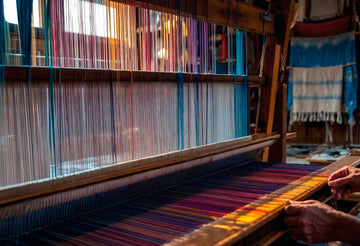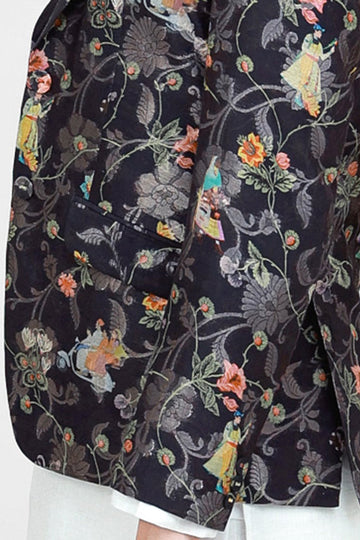Long before the term "sustainable fashion" became a global conversation, India was living it, quietly, mindfully, and with deep cultural conviction. Clothing in India was never just about covering your body; it was a statement of identity, climate responsiveness, artistry, and respect for nature.
Today, as we once again turn towards sustainable and ethical fashion, let’s remember this trend has been around far before the runways existed. Far before the establishment of modern society. This trend started in the cotton fields and was shaped on the wooden charkha and by hand weavers.
Let’s be clear; sustainable evolution of fashion in India is not a new movement. It’s a homecoming.
India’s Fabric of Time: A Timeline of Sustainable Clothing
India’s relationship with khadi is more than 5000 years old. From early civilisations to freedom movements, here are key moments that show how this legacy was never a trend—it was a way of life.
2500 BCE – Indus Valley Civilisation
Yes, we are going BCE. Archaeological findings from ancient civilisations like Mohenjo-Daro reveal cotton-based clothing. These garments suited the tropical climate and were made using natural, biodegradable materials.
1600–1500 BCE – The Origins of Iconic Indian Drapes
Clothing items we know today as saris and lehengas were recorded in 1600-1500 BCE. These pieces of traditional wear were not just worn in India but also traded to European countries. These were unstitched, free-flowing garments that allowed maximum reuse, no fabric waste, and adaptability across generations.
362 BCE – When the West Took Note
When Alexander the Great’s troops entered India, it is known they were in awe of the lightness and comfort of Indian khadi clothes. The records speak of their admiration for how the fabric kept the locals cool in the oppressive heat.
1918 AD – The Khadi Movement
Led by Mohandas Karamchand Gandhi, the Khadi Movement transformed homespun cotton into a tool of economic independence and resistance against British colonialism. Spinning khadi was no longer just a chore; it has become the symbol of freedom, self-reliance, and dignity. It challenged the machine-driven excesses of industrial textiles and revived the value of local, handmade, and ethical production.
The Ancient Indian Ethos of Conscious Dressing
For centuries, Indian fashion, knowingly or unknowingly, followed one simple yet powerful principle: “Wear what the earth gives, and give back nothing harmful.”
Traditional Indian garments were often made with locally grown cotton, wool, or silk. The use of natural dyes extracted from roots, leaves, bark, and minerals meant that garments returned harmlessly to the soil after their life cycle ended.
Communities practised slow weaving techniques on handlooms, passing knowledge from one generation to the next. The result was fabric with soul.
There was also an intuitive climate response in dressing. Regions developed their own styles based on seasonal rhythms. Light, breathable cotton clothes were staples in southern and central India, while insulating woollen clothes were used by the northern and northeastern populations.
The Khadi Revolution: When Clothing Became a Protest

In the early 20th century, as British rule intensified its grip over India’s economy, imported mill-made fabrics flooded Indian markets. In response, Gandhi ji ignited a movement that would bring fashion revolution in India.
Khadi wasn’t just a homespun cloth anymore; it became an act of resistance. By urging Indians to spin their own yarn and weave their own cloth, Gandhi created a ripple effect across the country. Villages became self-reliant. Foreign machine-made cloth was burnt as a rejection of economic control.
The spinning wheel became a national symbol of freedom.
The khadi movement started by Gandhi ji is quite similar to today's sustainable fashion trend. It led to:
- Local over global
- Handmade over machine-made
- Purpose over profit
The legacy of sustainable clothing in India continues to inspire conscious designers and consumers even today.
The Return to Roots: India's Contemporary Revival

Contemporary Indian fashion sector today is witnessing a thoughtful reawakening. From grassroots labels to global runways, many sustainable clothing brands like Adam Leaves are returning to ancient wisdom to meet modern needs.
- We are reviving forgotten weaves like organic cotton and hemp.
- We are working with artisans who once faced extinction in the face of fast fashion and giving them new life.
- We have nothing to hide. We practice complete openness in our processes and practices
- We are bringing back natural and eco-friendly dyeing practices.

We believe sustainable fashion is not only about saving the environment; it’s also about actually manufacturing fashionable and trendy clothing. The revival of khadi fashion carries the scent of soil, history, and home in each piece of clothing. It shows that nature isn’t just around us, but also present within us.
Why This Legacy Matters More Than Ever?
The negative impact of fast fashion on nature is no longer a secret. Overflowing landfills, exploiting labour, and cheap mass-produced clothing have landed enough trouble for the environment.
In this context, India’s age-old fashion philosophy offers a perfect solution. It’s a perfect example that:
- Fashion can be climate-conscious without losing beauty.
- Clothing can empower communities, not just corporations.
- What we wear can reflect not only who we are but also what we believe in.
Conclusion
India’s fashion revolution didn’t begin with the green movement; it began with our relationship to the land, to labour, and to legacy. Every thread spun by hand, every natural dye, every conscious drape tells a story of balance between human need and nature’s rhythm.
Today, as a new generation of designers and consumers seeks meaning in fashion, the most powerful answers might lie not in the future but in the past.
If you are interested in adding some sustainable clothing to your wardrobe, Adam Leaves is an amazing place to start. We have an amazing and 99% sustainable collection of shirts, trousers, jackets, blazers, dresses and more. Shop now.





